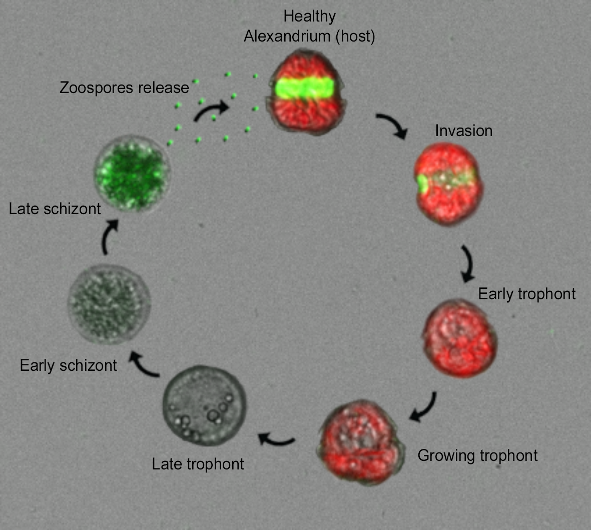Microbial Host-parasite Interactions in Marine Environments.
Marine phytoplankton and their large-scale proliferations (known as blooms) contribute to half of global primary production, fixing CO2 which is then recycled through heterotrophic interactions underpinning the biogeochemistry of the ocean. Protist parasites infect phytoplankton, control their dynamics and therefore, influence in nutrient cycling by altering the carbon fluxes across trophic levels. Yet the functional nature of such interactions remains a black box. There is very little knowledge regarding the biology of microbial-parasitic interactions in the ocean, with the molecular mechanisms underlying the infection processes universally under-explored.
Dinoflagellate algae cause harmful/toxic blooms in coastal areas, poisoning marine ecosystems, affecting human health and generating losses to local and regional economies by affecting aquaculture and tourism. We don’t really understand what drives the rise of these blooms and more importantly what makes them decline. It is now clear that protist parasites of these toxic algae are an important controlling agent that contribute to the termination of toxic algal blooms.
The aim of our project is to study how protist parasites belonging to Perkinsea interact with their blooming dinoflagellates hosts. We apply a variety of ‘omic’ approaches (genomics, meta-transcriptomics, and single-cell transcriptomics) combined with high-throughput imaging, to reveal key molecular mechanisms and cellular processes that encode parasitic interactions in algal infections; this remains an important challenge if we are to understand and manage these phenomena. We are currently developing a series of unique approaches to study marine protist host-parasite systems in culture and natural environments, which will transform the way we study single-cell interactions, and understand the cellular systems that determine these interactions that are so critical to shaping the marine environment.

Watch the Infection Live!